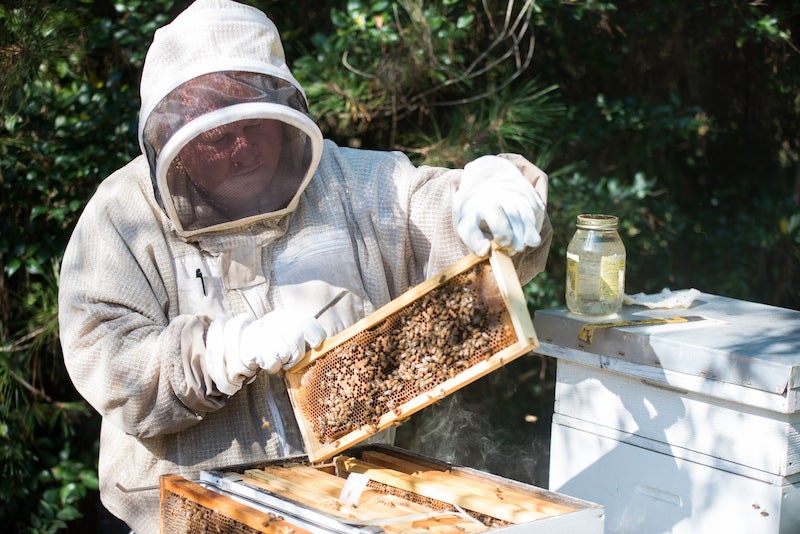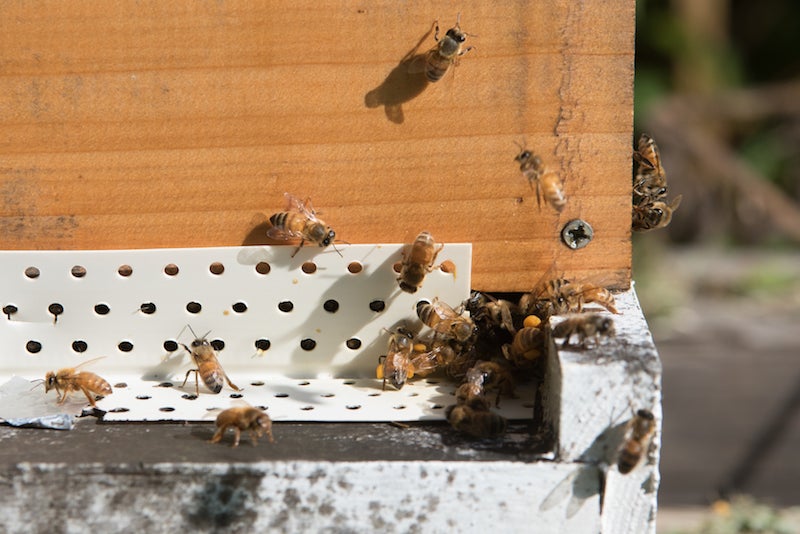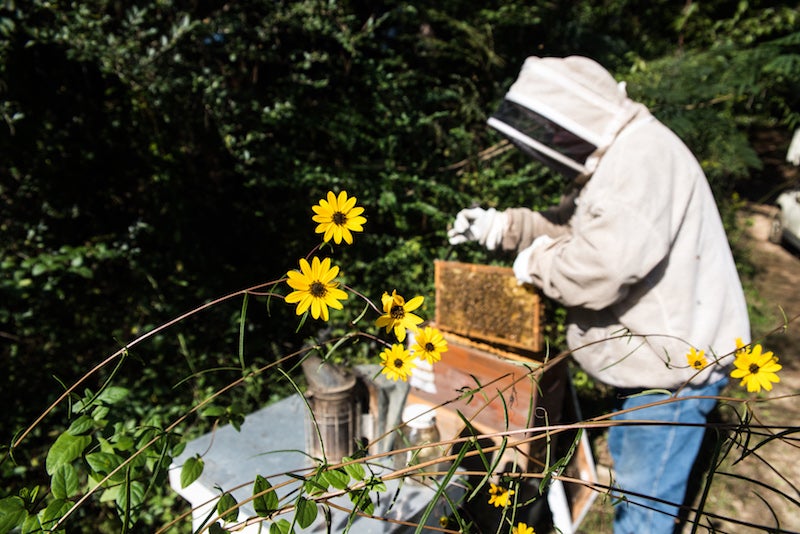Harvesting help: locals working to save bees from extinction
Published 4:37 pm Friday, October 6, 2017
Once a week, Calera resident Tom Haney goes outside to care for the tens of thousands of bees that he keeps, as he has been for the past eight years. Since his retirement, Haney has taken up beekeeping as a hobby, like many other beekeepers throughout the county.
“I started it in 2009,” Haney said. “I had a friend who was doing it and I got interested.”
Recently elected incoming Shelby County Beekeepers Association president Kelley Frederick said many locals have taken up beekeeping for a variety of reasons.
“Many people are interested because it pollinates their gardens,” Frederick said. “Some people just have a love of bees, so they want to actually grow bees. Without bees, you wouldn’t have food, so you have to have the pollination to go with it. People are also interested in the honey factor. People want to sell honey. And some people just want to have a hobby. Some people are curious, or they just like a challenge or they like the thrill of it.”
Frederick said she first became interested in beekeeping after she observed the honeybees on her uncle’s farm as a teenager and joined the Shelby County Beekeepers Association years later.
“I joined it, and I was so fascinated by it that now I’ve joined the master beekeeper program,” Frederick said. “
Haney is one of about 200 registered beekeepers associated with the Shelby County Beekeepers Association, according to current president and charter member George Baldwin.
“We’re primarily for educating people who want to become beekeepers,” Baldwin said. “We teach the basics about getting started with bees, from equipment to protection, learning what to do with their bees and how to get started. We try to mentor them to where they can get their first year in successfully raising a colony of bees for the next year.”
Baldwin said the Beekeepers Association was formed in 2011, and grew from a handful of people to a couple hundred members in less than a decade and has moved to different locations to accommodate for the growth.
“There were about six people who were interested in forming an association. We formed that with our bylaws and met at the Pleasant Site Church,” Baldwin said. “After the first year, we went to the Chelsea Senior Center, and then we outgrew that.”
Meetings take place on the first Thursday of every month. The meetings currently take place at the First Presbyterian Church of Alabaster. However, Baldwin hopes to move the meetings to the new sports complex in Pelham, once it is built, and increase the frequency of the meetings to bi-monthly.
Starting in January, the Beekeepers Association holds a 7-week course for those interested in getting started. Baldwin said applications open in early November, and admission is limited to 45 people per course.
“This is our sixth year,” Baldwin said. “We have a cut off, because there are more people who apply, but we just don’t have the capacity.”
Additionally, many members have given presentations on beekeeping to schools, civic groups and gardening clubs.
Because beekeeping is such a unique hobby, Baldwin said beekeepers throughout the county, as well as throughout the state, are a close-knit and supportive group of people.
“We have a great group. We’re almost like family, as far of the social part of it,” Baldwin said. “It’s also tied in with beekeeping, and we try to educate as many people as we can.”
THE BASICS OF BEEKEEPING
Haney said starting a beehive begins with a single box. According to Haney, a beehive consists of one to two boxes known as “brood boxes,” which contain larvae bees and eggs. The eggs and larvae are stored in multiple, removable frames in the box.
“Honey supers,” from which honey is extracted are smaller boxes stacked on top of the brood boxes. Honey supers also contain frames, where the honey is stored.
Haney said he and other beekeepers wear special protective gloves and hooded jackets to shield their arms and faces from bee stings. To keep the bees calm while they are being cared for, Haney said beekeepers use a smoker: A metal apparatus that contains burning straw and releases smoke onto the hive.
“I’ll go through individual frames to make sure the queen bee is laying,” Haney said. “If I see brood (larvae and eggs) then I know that everything is good.”
Because honey serves as food for the bees, Haney said he only extracts honey once a year to make sure they have a large food supply.
HARVESTING HONEY
Like any other crop, Frederick said there is a specific season for collecting honey and other products made by bees.
“We have to have a beginning and an end to honey season,” Frederick said. “Bee season starts on the winter solstice and then it ends at the summer solstice. They work by the sun. In the summer, once they have capped (produced beeswax) over the frames, then we know it’s ready.
According to Frederick, honey is collected through a machine known as an extractor. Frederick said the caps are taken off of the frames and placed inside of the extractor and spun until all of the honey is released from the frames and drains out into a bucket.
“Some people will call it a slinger, a spinner or an extractor. It’s all the same,” Frederick said. “After that, we put the bucket on the counter and open it and bottle it up and sell it.”
According to Baldwin, honey has no expiration date and contains multiple medicinal properties.
“They are finding out all kinds of information now about the uses of honey. They’ve been using it on burn victims in hospitals, they use it against MRSA, which is a strain of bacteria that’s kind of hard to treat with the antibiotics we have now. Putting it on cuts will help form hydrogen peroxide when exposed to the air, which is a very good antibiotic. And, of course, it helps people with their allergies,” Baldwin said.
Baldwin said beeswax and honeycomb are also valuable byproducts.
“They are used to make candles, hand creams, soaps and different things,” Baldwin said.
WHAT’S THE PROBLEM?
“Back in the ‘80s, somehow there was a mite that got into the bees from contact with other bees. It was a big thing, but it was easily treatable.,” Baldwin continued. “In 1991, the Varroa mite was introduced. They think it came through a South Carolina port or it could have come in with Africanized bees out of South America.”
Baldwin said the highly infectious Varroa mite is the number-one killer of hives all over the globe.
“They say that if you don’t have Varroa mites, you will be getting them,” Baldwin said. “These mites are like if a soccer ball was attached to us. You can see the mite on the bee. August and September are the critical months where mites build up the most. You have to be constantly checking.”
While local beekeepers face many issues while maintaining their beehives, Baldwin said local beekeepers are helping combat the Varroa mite and other problems by continuing to breed queens and pollinating plants on local farms.
Baldwin said the extinction of bees would have serious, negative consequences for humans and other animals on Earth.
“It would decrease our food supply by a third. We would be living off of corn, wheat, oats rye and grains,” Baldwin said. “If we don’t have pollination, we don’t have seeds to plant. All of your fruits and vegetables are pollinated by pollinators. Honeybees are not the only pollinators, we’ve got bumblebees and several kinds of small wasps, but they’re on the decline too.”
Once fruits and vegetables are no longer being produced, Baldwin said herbivorous animals, and then carnivorous animals, will eventually also run out of food, which will disrupt the entire ecosystem.
“Einstein predicted that we will have three years left after we lose our bees,” Baldwin said.
CAN IT BE SOLVED?
Currently, Baldwin and Haney said the majority of beehives are not capable of functioning properly on their own and require human assistance.
“If it weren’t for beekeepers, there probably wouldn’t be any bees,” Haney said.
“From the ones that are making it out there now, we’re trying to get their genetics and see what the relationship is with the Varroa mite,” Baldwin said. “We’re taking what we call ‘survivor hives’ and we use their genetics to try to improve the stock that we have.”
Baldwin said he doesn’t anticipate that the number of survivor hives will increase in the future. For the past three decades, Baldwin said responsibility for the preservation of the bee population has fallen on the shoulders of humans.
“There will always be survivor hives out there that can sustain themselves, but not like it used to be,” Baldwin said. “If they’re not sustained by a beekeeper, I would say it would drastically reduce the bee population of the world.”
However, Baldwin said there is still hope in that beehives can easily be established.
“We can take a hive coming out of the spring and we can split it and make four hives out of it,” Baldwin said. “Even though we’re losing hives, we can build them back up really quickly. Continually, we are increasing our hives to recover our losses.”












